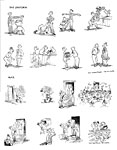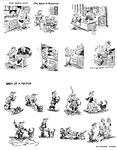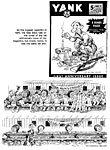GEORGE
BAKER AND THE SAD SACK
And
A Few Others from Yank, the Army Weekly
NOBODY
EVER HAD IT AS BAD as the Sack—the Sad Sack, George Baker’s perpetually
luckless anti-hero of World War II. The world was poised to dump on him, and
Baker made sure it did—creating in the process one of the most popular cartoon
characters of the twentieth century.  Ironically, everything came up roses for Baker. Ironically, everything came up roses for Baker.
Baker
was born May 22, 1915 in Lowell, Massachusetts, son of Harry Baker, a middle
class merchant, and Mary Portman. In 1923, the family moved to Chicago
where young George attended Roosevelt High School. After graduation, he
held a succession of inconsequential jobs (truck driver, cleaner and dyer
assistant, salesman, clerk) before becoming assistant ©. 1935) to a commercial
artist. In 1937, he applied to Disney Studios for a job, was accepted,
and moved to California. He worked in the Effects Department on such
full-length features as “Pinocchio,” “Dumbo,” and “Bambi.” In June 1941
Baker was carrying a picket sign in the notorious animators' strike against
Disney. Just as he was about to run out of money, he was drafted into the Army
and sent to Fort Monmouth, New Jersey, for basic training, after which he would
be assigned to the Signal Corps to do animation for training films.
At
the time, Pearl Harbor was still six months in the future, and many of Baker’s
fellow inductees expected to be returned to civilian life before the end of the
year—“Ohio,” as they said (“Over the Hill in October”). In the meantime, as
Baker observed, “civilian ignorance of the Army was appalling. Everyone seemed
to have been educated to the military through the movies. ... Simple terms such
as K.P. or Inspection drew a blank and needed explanation. In an endeavor to
rectify this sad state of affairs and also to occupy my evenings with something
constructive for a change, I decided to do some cartoons that would explain
pictorially what Army life was like.”
He
started by devising an authentic average soldier “to refute the ads that were
then beginning to make their appearance, in which soldiers always looked bright
and cheerful, bedecked in tailored uniforms immaculately pressed and shined.”
To create his new khaki Truth, Baker “reached into the psychological, if not
actual, reality” and pulled out the Army Everyman, whom Baker saw as a hapless
and perpetual victim in the Army's grand scheme of things. "The
actual state of mind of a soldier was more authentic and real to me than his
outer appearance," Baker wrote in the Preface to The New Sad Sack (1946), "so therefore my character looked resigned, tired, helpless, and
beaten. Going the whole hog, he looked clumsy and even a little stupid, but
these last two elements were actually unintentional and only slipped in because
I was still a bit rusty in my drawing.”
Baker
hoped to sell his as yet unnamed creation into newspaper publication and made
the rounds of newspaper offices in New York, only fifty miles from Fort
Monmouth. When no one proved interested, Baker gave up on the idea until the
Defense Recreation Committee in New York ran a cartoon contest for soldiers in
the spring of 1942; he submitted one of his cartoons and won.
Marion
Hargrove, noted later for his hilarious tome about his Army experiences, See
Here, Private Hargrove, described this watershed cartoon in the Preface to
the first Sad Sack book: “In the first drawing, this pathetic dogface
lay supine and sloppy upon his tousled bunk, oblivious to the filthiness and
disorder the characterized his little corner of the barracks. In the course of
the next ten drawings, he rose and made his bed, cleared away the scattered
clothing and newspapers and old candy wrappers, swept and mopped the floor,
pressed his uniform, shined his brogans, polished his brass, bathed, shaved,
dressed himself immaculately, and stood at the foot of his bunk, trim and erect
in the midst of sparkling order and cleanliness, while the inspecting officers
passed on their rounds. In the last picture, the inspectors had gone, and our
hero again lay supine and sloppy upon his tousled bunk, surrounded by the same
scattered clothing and newspapers and old candy wrappers. It was the full
military cycle caught in a newspaper cartoon.”
The
publicity provoked by the cartoon attracted the attention of Major Hartzell
Spence, who was then in New York, assembling material and a staff to produce
the weekly Armed Forces tabloid magazine, Yank. Invited to submit
a cartoon every week, Baker titled his feature The Sad Sack (employing
Army slang for a worthless soldier, "a sad sack of shit") and began
contributing with the first issue of Yank, June 17, 1942.
In
this vicinity, we post the inaugural Sack. Also the first military publication
appearance of G.I. Joe, the creation of Dave Breger (see Harv’s
Hindsight for July 2009 to learn that Breger’s autobiographical cartoon
series had been appearing in the Saturday Evening Post for some months
before being drafted by Yank). 
The
24-page first issue of Yank offered a full page of cartoons, “Between
the Lines,” and also printed several cartoons throughout. Joining the Sack on
the page of cartoons were the efforts of contributors, some of whom (like
Private Jaro Fabry, see Opus 234; and Private Ralph Stein, who
was a Yank staffer) would have memorable post-WWII cartooning careers.
Other contributors over the next several years who joined the post-war parade
of professional cartoonists included such luminaries as Bil Keane (already
signing his name with one ‘l’ but being credited in type with two), John
Ruge, Irwin Caplan (Hindsight, May 2007), and various others,
among them, the ubiquitous Ned Hil-ton, who seems to be everywhere in
single-panel gag cartooning for the entire first half of the twentieth century.
Samples of their work appear at the end of the scroll in our Sad Sack Gallery.
Despite
the work of a distinguished line-up of cartoonists, Breger’s G.I. Joe was
the presumed star; Breger, after all, was nationally known because of his
soldier cartoons in the Saturday Evening Post. Early promotions for Yank plugged Breger’s cartoon and made “little or no mention of the Sack,” Baker
observed. But it was a short-lived fame: “G.I. Joe ran in Yank for about eight months until one day Breger, who was in London at the time,
accepted a commission of Second Lieutenant in Special Service, and his strip
had to be dropped; Yank’s policy was that contributing members of its
staff had to be in enlisted grade.”
The
War’s most famous enlisted cartoonist, Bill Mauldin, never made it into Yank. Baker reports that Mauldin submitted many cartoons, but Yank’s feature
editor rejected almost all of them, and Mauldin, fed up, wrote him a scathing
letter, denouncing the editor, the magazine, and the cartoons in it and vowing
that he was through with Yank. The name of this benighted editor has
been lost to history.
A
few months following the Sack’s debut in Yank, Baker was transferred to
the staff of the magazine, and he served there for the duration of World War
II. Yank sent Baker to military installations all over the world
to expose him to every possible phase of Army life in order that he might
reflect it in the cartoon. In the early months of Yank’s run, Baker also
distributed subscription blanks wherever he went. Eventually, the magazine
acquired a circulation department, which involved Baker only to draw
promotional posters. One of these gave the cartoonist “the first tangible
evidence” that the Sack was a success. The poster said: “Subscribe to Yank and see the Sad Sack every week.”
Baker
shouldn’t have worried. As perennial low man on the regimental totem pole, the
Sad Sack was popular from the very start. He epitomized the frustrations
and disappointments of Everyman, dragged somewhat reluctantly into a military
bureaucracy he didn't understand and could never master. The Sack's
adventures took place entirely in pantomime; each cartoon was a series of
eight-to-ten borderless pictures that progressively depicted the cascading
persecution of the week. Like some dumb animal being inexplicably
punished for behaving in a perfectly natural way, the Sack was all the more
pitiful for being mute.
 |
 |
The
Sad Sack's personal agonies begin immediately upon his induction: when
his first uniform fits him perfectly, his sergeant orders him to take it off so
he can be supplied with one that doesn't fit. The Sack always gets the
worst assignments in camp. He is perpetually on K.P. ("kitchen
police") duty, peeling potatoes and washing pots and pans. When he
spends a whole day cleaning the latrine and making it spotless, his comrades
mess it up in minutes when they return from the day's training. When he
works hard, his superiors are promoted and he gets more K.P. When he
finds a girl, she deserts him for a sergeant or an officer. The Sad Sack
never wins; but he never gives up either. He always comes back the next
week.
Baker
drew with a bold outline which he soon began to embellish with hayey shading,
creating a gritty, raunchy visual ambiance for the feature. Human anatomy
as the cartoonist portrayed it was bony and lumpy, and clothing draped on such
constructions forever bagged at the knee and wrinkled everywhere. The
Sack himself was a chinless apparition of comic as well as sad aspect with his
sausage nose, huge ears, and weary, meek expression; and the forces opposed to
him—sergeants and officers—were lupine predators, fanged and snappish,
intimidating even in appearance. The Sad Sack was primitive—even
crude—in its visual style, but that suited the subject: a powerless cog
in a machine he never made, the Sack with his sagging, rumpled, awkward
physique and hangdog expression was the personification of the Army's typical
private, a pathetic dogface, frazzled and worn, destined to be defeated by
every circumstance he encountered.
Wrote
Baker (in The New Sad Sack): "The greatest source of material
for the Sack was the Army itself.... [A]ny idea based on the machinations
of the Army, the red tape, officers or the thousands of consistent
inconsistencies of the system would be accepted and understood by G.I.'s everywhere.
The underlying story of the Sad Sack was his struggle with the Army in which I
tried to symbolize the sum total of the difficulties and frustrations of all
enlisted men."
The
popularity of the Sack may be gauged by his cover appearance on Yank’s first
anniversary issue, and by a convivial tongue-in-cheek “expose” in the issue for
December 10, 1943. The article alleges that Baker’s character is actually a German spy,
descendant of a fifteenth century Nurenberg family known as Sad Sach, the
origins of which can be traced back to 1494 to a Hans Sad-Sach, shoe-maker,
“who was a celebrated meistersinger and German poet of many works, who
died in 1576.” The spoof gives itself away early by saying that Yank “claimed to be The Army Weekly.” The article alleges that Baker’s character is actually a German spy,
descendant of a fifteenth century Nurenberg family known as Sad Sach, the
origins of which can be traced back to 1494 to a Hans Sad-Sach, shoe-maker,
“who was a celebrated meistersinger and German poet of many works, who
died in 1576.” The spoof gives itself away early by saying that Yank “claimed to be The Army Weekly.”
After
the War, Baker left the Army, married Brenda Emsley (on May 29, 1946), moved to
Los Angeles, and formed Sad Sack, Inc., through which he marketed his
creation. The Sack also resumed civilian life.
Bell
Syndicate had been distributing reprints of the Yank cartoons since
1945, and on May 5, 1946, it launched a Sunday Sad Sack comic strip with
entirely new material; a daily started September 8, 1952. But it was a
somewhat depressing feature. As a portrayal of civilian life, the strip
seemed unduly cynical and bitter: here the Sack encountered nothing but
predatory con men, crooks, and heartless, conniving women, and he was
victimized by their malevolent premeditation rather than by the uncomprehending
and therefore comic blunderings of monumental military inefficiency. The
daily strip ceased after only a year; the Sunday, in 1958.
Baker
had more success with a comic book incarnation of the Sack (for which pantomime
was abandoned). Launched by Harvey Publications in the summer of 1949
(cover date September), The Sad Sack lasted with various titles (Sad
Sack and the Sarge, Sad Sack Army Life Parade, Sad Sad Sack World, etc.)
until mid-1982 (with a six-issue revival in 1992-93), drawn mostly by Fred
Rhoad.
Initially
a civilian in the book, the Sack reenlisted in the spring of 1951, and his
return to Army life made the comic book, aimed at a teenage audience (not at
servicemen), a bestseller during the Korean War and after even though Baker no
longer drew the feature (except, it sez here, for covers). The Sack also
inspired a 1957 motion picture, starring Jerry Lewis. Although the
Sad Sack secured a living for Baker until his death May 7, 1975 from cancer,
the Sack never again achieved emblematic status for an entire generation, as he
had during World War II, when he suffered in silence as did Everyman in
uniform.
Our
too-short Sad Sack Gallery includes only the Yank Sacks, finishing with
a few heralding the end of the War in Europe, the transfer of the Sack to the
Pacific (where the War continued for another four months), and, finally, the
conclusion of hostilities and the Sack’s sad approach to civilian life. Also on
display are several episodes of the Sack’s troubles with women. G.I.s are always
on the prowl for female “companionship,” and the Sack, if he is to be as
representative as Baker intends, must be no different. I’ve included several
encounters here because of the udderly outlandish way Baker portrays the female
of the species. Few cartoonists are able, as he is, to make sexy women look so
pendulous as to be nearly repulsive. Also among the ensuing specimens is one of
the few times the Sack comes out ahead—when he blunders into bayoneting a
sergeant. The final two clusters exhibit the work of some of the other Yank cartoonists who went on to post-War celebrity. (If you can’t read the captions,
click on Page, then Zoom, then pick, say, 150% enlargement.)
Bibliography. The chief source for
most of the information about George Baker's life is the obituary printed in The
New York Times, May 9, 1975. A few additional details may be found in The Encyclopedia of American Comics (1990), edited by Ron Goulart; in
"Sad Sack," an article by Gordon and Mary Campbell in Cartoonist
PROfiles No.69 (March 1986); and in the front matter of the two Simon and
Schuster collections of the Yank cartoons: The Sad Sack (1944) and The New Sad Sack (1946), especially the latter which begins
with Baker's own account of his life before and with the Sack.
Return to Harv's Hindsights |